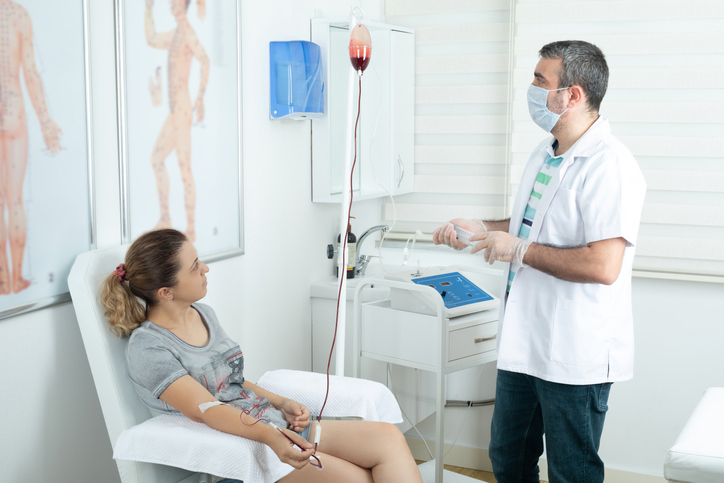Ozone Therapy – What You Need to Know

By Joy Stephenson-Laws, JD, Founder
I am a big proponent of keeping an open mind about new, alternative approaches to wellbeing. For me, it’s important to balance what most people know as “traditional” practices with more innovative practices to maintain our health. I have tried and continue to use alternative therapies such as cryotherapy, acupuncture, red-light therapy, ocean therapy and vitamin infusions.
I have recently researched and began doing ozone therapy. You may remember ozone (a colorless gas composed of three oxygen atoms and with the formula O3) from your high school science class as the gas in the atmosphere that helps protect us from the sun’s radiation. It is also a component of air pollution which is formed from the reaction between nitrogen oxides and volatile organic compounds. This ozone irritates our lungs and can cause cough, throat irritation, discomfort when breathing and shortness of breath.
This same ozone also has been studied and used for over 150 years in parts of the world for its potential health benefits. It is so widely used for therapeutic purposes that there is even an International Scientific Committee on Ozone Therapy. This therapy was introduced in the U.S. in the 1980s. While its use has been approved in variety of countries, such as Brazil, Germany, Italy, Turkey, Greece and Mexico, it is still considered an “alternative therapy” in the U.S. since it currently does not have FDA approval for medical use.
Ozone was used in the early 20th century to disinfect drinking water. During the first World War, doctors used it to help disinfect wounds. Today, alternative medicine practitioners use O3 to treat a variety of medical conditions. Because it is a respiratory irritant, ozone is not and should not be inhaled. Instead, medical grade O3 is mixed with liquids and injected into the body intravenously (through a drip, for example), intramuscularly (an injection), or subcutaneously (just under the skin). Some practitioners also may draw your blood, mix it with ozone, and then return the ozonized blood to your body. It also may be applied directly to the skin or blown into the body, for example in the rectum.

The goal of ozone therapy is to increase the amount of oxygen in your body. This higher level of oxygen is thought to boost your immune system, improve blood circulation, reduce oxidative stress and promote natural healing. Proponents of ozone therapy claim that it is beneficial for a wide variety of diseases and conditions. These include:
- Infected wounds
- Macular degeneration
- Rheumatism/arthritis
- Dental cavities
- Breathing problems
- Immune disorders
- Fibromyalgia
- Heart disease
- Alzheimer’s disease
- Diabetes complications
Other studies have reported that patients receiving ozone therapy demonstrated increased muscle strength, improved mobility, increased energy and improved general health.
Risks & Side Effects
If you are considering ozone therapy, keep in mind that as with any type of therapy (traditional or alternative), there are possible risks and side effects. With ozone therapy these include:
- Lung irritation from inhaling even a small amount of O3
- Air bubbles from IV ozone therapy may cause an embolism that can cause a blocked vein or artery which may cause stroke or heart attack
- Cramping and discomfort if the gas in blown into your body through your rectum
- A flu-like condition known as Herxheimer reaction
- Numbness or tingling in the lower limbs
- Temporary worsening of pain
Please keep in mind that ozone therapy, along with other alternative therapies, are meant as complements to other therapies and treatment programs and should only be done after consulting with your personal healthcare practitioner. If you do want to try it, be sure to choose a provider with experience in ozone therapy. This gas needs to be used in exact amounts and applied/used correctly. You should never try to self-administer the gas.
Enjoy your healthy life!
Disclaimer: This article is not intended to provide medical advice. Please consult with your doctor or another competent healthcare practitioner to get specific medical advice for your situation.
The pH professional health care team includes recognized experts from a variety of health care and related disciplines, including physicians, attorneys, nutritionists, nurses, and certified fitness instructors. This team also includes the members of the pH Medical Advisory Board, which constantly monitors all pH programs, products, and services. To learn more about the pH Medical Advisory Board, click here.







